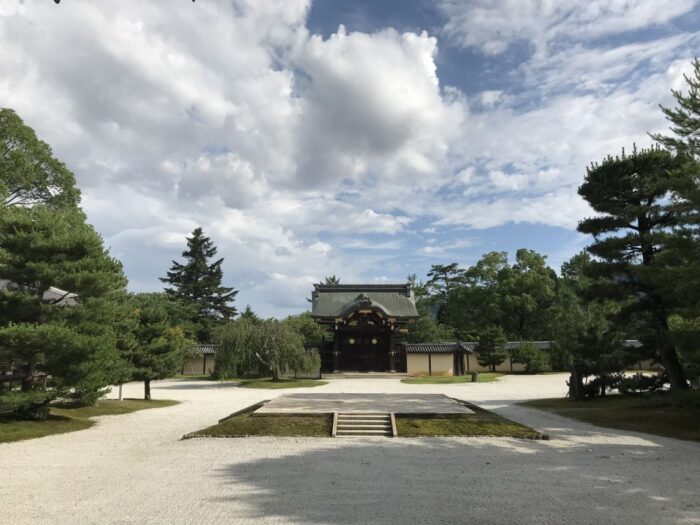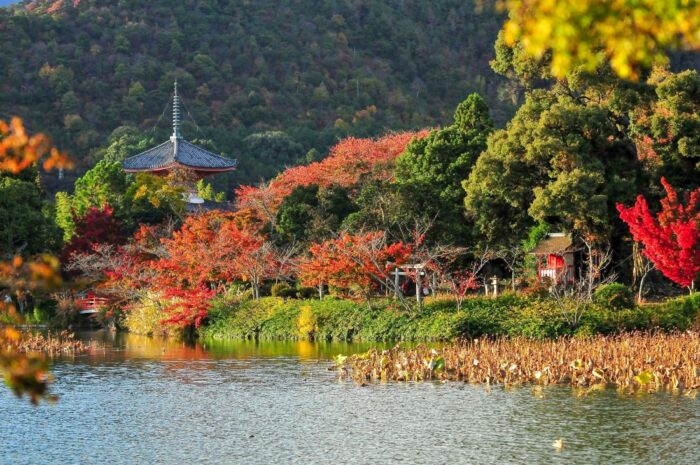The moon-viewing tradition at Daikakuji Temple in Kyoto is a serene and culturally enriching experience. Dating back to the Heian period, this tradition has captivated nobles and visitors alike for centuries.

At Daikakuji, visitors can partake in the timeless practice of Kangetsu no Yūbe, where they can sip alcohol, compose poems, and admire the full moon from ornately styled boats on Osawa-no-ike Pond. Buddhist priests also perform sacred rituals and sutra concerts, adding a spiritual touch to this magical event.
With the autumn foliage and nighttime illumination, Daikakuji Temple offers a truly unforgettable cultural experience.
Key Takeaways
- The Moon-viewing tradition at Daikakuji Temple is a popular event that stems from the Heian period.
- The tradition involves sipping alcohol, composing poems, and appreciating the full moon.
- The temple is set amidst the scenic beauty of Osawa-no-ike Pond, Japan’s oldest surviving man-made garden.
- Visitors can enjoy riding ornately styled Ryū-tō Gekishu boats, witness sacred Buddhist rituals, and experience autumn foliage and illumination events.
History of Moon-viewing Tradition at Daikakuji
The history of the moon-viewing tradition at Daikakuji dates back to its establishment in 876 and its connections to the Japanese Imperial Family. This serene cultural experience has been enjoyed for centuries by both nobles and commoners alike.
The tradition originated during the Heian period when nobles would gather on lake boats or moon viewing platforms to appreciate the full moon. They would sip alcohol, compose poetry, and enjoy the beauty of the moonlit night.
Today, this tradition continues to thrive in Japan, especially in Kyoto, where Daikakuji Temple is located. Set amidst the scenic beauty of Osawa-no-ike Pond, Japan’s oldest surviving man-made garden, the temple provides the perfect backdrop for moon-viewing.
Visitors can participate in the Kangetsu no Yūbe event, ride ornately styled Ryū-tō Gekishu boats on the pond, and witness sacred Buddhist rituals.
The moon-viewing tradition at Daikakuji offers a unique and personal connection to Japan’s rich cultural heritage.
Daikakuji Temple: A Cultural Gem in Kyoto

Nestled in the picturesque city of Kyoto, Daikakuji Temple stands as a renowned symbol of Japanese history and tradition. With its establishment in 876 and its historic connections to the Japanese Imperial Family, the temple holds a significant place in Japan’s cultural heritage.
Set amidst the scenic beauty of Osawa-no-ike Pond, Japan’s oldest surviving man-made garden, Daikakuji Temple offers visitors a serene and immersive cultural experience. As visitors explore the temple grounds, they can witness the moon’s reflection on the tranquil waters of the pond, creating a mesmerizing sight.
Plus, the temple hosts various events and rituals, such as the Kangetsu no Yūbe tradition, sacred Buddhist rituals, and autumn foliage and illumination events. These experiences add to the temple’s cultural significance and provide visitors with a deeper understanding of Japanese customs and spirituality.
Kangetsu No YūBe: a Timeless Tradition
Visitors can enjoy the Kangetsu no Yūbe festivities at Daikakuji Temple. They can ride ornately styled Ryū-tō Gekishu boats on the picturesque Osawa-no-ike Pond. These boats, adorned with dragon or waterfowl designs, offer a unique and enchanting experience.
Here are three highlights of the event:
- Boat Ride: Guests can hop on these beautifully decorated boats and glide across the tranquil waters of Osawa-no-ike Pond. It’s a chance to feel the gentle breeze on their faces and soak in the serene atmosphere.
- Moon Viewing: As they ride, visitors can marvel at the moon’s reflection on the water’s surface, creating a mesmerizing sight. The moon’s ethereal glow adds a touch of magic to the experience.
- Festive Atmosphere: Along the lakeside pagoda, visitors can enjoy live music and explore food stalls offering a variety of delicious treats. The festive ambiance, combined with the beauty of the moon and the surroundings, makes for a truly memorable evening.
Immersing oneself in the Kangetsu no Yūbe tradition at Daikakuji Temple is a timeless experience. It allows visitors to connect with Japan’s rich cultural heritage.
Sacred Rituals and Sutra Concert at Daikakuji
Witnessing young monks singing classic sutras during the Sacred Buddhist Rituals and Sutra Concert adds a spiritual and solemn atmosphere to the festivities at Daikakuji Temple. The hauntingly beautiful melodies fill the air, transporting visitors to a different time and place.
The deep resonance of the monks’ voices, combined with the ancient texts they chant, creates a sense of reverence and awe. As the music flows through the temple halls, one can’t help but feel a connection to the past, to the traditions and beliefs that have been passed down through generations.
It is a truly moving experience, a glimpse into the spiritual practices that have shaped the lives of so many. The Sutra Concert is a highlight of the moon-viewing event, a reminder of the deep cultural significance of Daikakuji Temple.
Autumn Foliage and Illumination at Osawa-no-ike Pond
The vibrant colors of the autumn foliage at Osawa-no-ike Pond create a picturesque backdrop for the illuminated surroundings. As visitors stroll along the pathways, they are greeted by the mesmerizing sight of leaves in various shades of red, orange, and yellow. The tranquil atmosphere of the pond is further enhanced by the soft glow of the nighttime illumination, casting a magical aura over the entire area.
Here are three reasons why experiencing autumn foliage and illumination at Osawa-no-ike Pond is a must:
- Immersive Nature Experience: Walking through the vibrant foliage offers a chance to connect with nature in a meaningful way, surrounded by the beauty of the changing seasons.
- Captivating Visuals: The combination of the autumn colors and the illuminated surroundings creates a visually stunning scene, perfect for capturing memorable photographs.
- Serenity and Relaxation: The peaceful ambiance of Osawa-no-ike Pond provides a serene escape from the bustling city life, allowing visitors to unwind and appreciate the beauty of their surroundings.
Frequently Asked Questions
What Is the Significance of the Moon in the Heian Period and Why Did Nobles Gather for Moon-Viewing Parties?
In the Heian period, the moon held great significance and nobles gathered for moon-viewing parties to appreciate its beauty. They enjoyed activities like composing poems and sipping alcohol while admiring the full moon.
How Are the Ryū-Tō Gekishu Boats Decorated for the Kangetsu No YūBe Event?
The Ryū-tō Gekishu boats for the Kangetsu no Yūbe event at Daikakuji Temple are adorned with ornate designs featuring dragons or waterfowl. These decorations add to the enchanting atmosphere of the moon-viewing experience.
What Is the Cost of Boat Tickets for the Moon-Viewing Event and How Can Visitors Purchase Them?
Boat tickets for the moon-viewing event at Daikakuji Temple cost 1,000 yen. Visitors can purchase them and choose from four boarding time slots. It’s a great opportunity to experience the serene cultural tradition.
Can You Provide More Information About the Mangetsu Hoe Ceremony Performed by Buddhist Priests During the Event?
During the moon-viewing event at Daikakuji Temple, Buddhist priests perform the Mangetsu hoe ceremony. This solemn ritual, believed to bring good harvests and well-being, adds a spiritual dimension to the cultural experience.
When Is the Peak Period for Autumn Foliage at Osawa-No-Ike Pond and How Does the Nighttime Illumination Enhance the Experience?
The peak period for autumn foliage at Osawa-no-ike Pond is from mid-November to early December. The nighttime illumination enhances the experience by creating a magical scene for visitors to enjoy the vibrant colors of the foliage.
The Sum Up
To sum it up, the moon-viewing tradition at Daikakuji Temple in Kyoto offers a serene and culturally enriching experience.
With its rich history dating back to the Heian period, the temple has become a cultural gem in Japan.
The Kangetsu no Yūbe tradition allows visitors to appreciate the beauty of the full moon while sipping on alcohol and composing poems.
The sacred rituals and sutra concerts performed by Buddhist priests add a spiritual touch to the event.
On top of that, the autumn foliage and nighttime illumination at Osawa-no-ike Pond create a magical atmosphere, enhancing the overall cultural experience.
Don’t miss the opportunity to immerse yourself in this timeless tradition and witness the breathtaking beauty of Daikakuji Temple.




